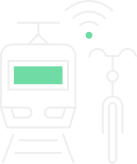Watch the Video
With more than half the world’s population living in cities and urban areas leading to overcrowding in cities and bringing people into ever-greater contact every day, the hustle and bustle of busy urban centres can cause a variety of challenges not only for residents but also for businesses, visitors, authorities and emergency services. With growing examples of challenges in managing large crowds at events and avoiding mass crushes, there is a growing need for better decision-making support resources to enable authorities, emergency services and event organisers and the like to be better prepared for such events. These can range from resources to address both the short-run (real-time interventions) or longer-run (planning) undesirable situations.
In the EMERALDS project, Argaleo and the Delft University of Technology are working closely with the municipality of The Hague to design a risk assessment, prediction and forecasting system to support decision-making. Being the political capital of the Netherlands, The Hague is often the stage of (political) demonstrations which, in some cases, escalate. Moreover, the city welcomes substantial numbers of tourists each year and has a vivid beach scene (Scheveningen), which causes the necessary challenges for the safety and accessibility of all stakeholders. Think of visitors, inhabitants, and entrepreneurs.
How EMERALDS will address the challenge
With an overwhelming amount of data available, EMERALDS will address how to make optimal use of them to provide reliable decision support for planning and operational management under stressful conditions. The use case will design a decision support system for municipalities to address several scientific and technical challenges:
- Determining which data/data sources are relevant to estimate, predict, and forecast the risks of irregularities.
- Predicting and forecasting the factors leading to these irregularities, including the estimation, prediction and forecasting of crowding and citizens' mobility plans in the case of major events.
Multi-dimensional identification of risk, based on the current and predicted physical and context characteristics of the situation using dedicated AI techniques.
How it will work
The use case focuses on the exploitation of extreme data analytics and AI for risk assessment, prediction, and forecasting by developing two methods. The first is aimed at the prediction and forecasting of the situational variables (e.g., crowding, but also weather and hazard dynamics). The second combines the prediction/forecast of the situational variables with the (observed) contextual variables (e.g., characteristics of the current event, the composition of the crowd being observed and sentiments in the public) to assess the risk level. The combination of the two methods results in a data-driven assessment of the risk and the need to intervene.


